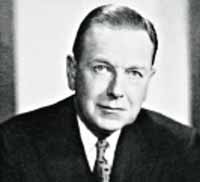
| William ANDERSON |
 |
 |
William Matheson Anderson nacque a Toronto nel 1905, si laureò presso la locale università in matematica e fisica e nel 1944 ricevette una borsa di studio dalla facoltà attuariale di Scozia un onore che nel secolo trascorso dalla sua fondazione era toccato a soli 14 studenti.
Entrato in una Compagnia di Assicurazione divenne uno dei primi attuari canadesi e maturò la sua carriera fino a diventare Presidente di entrambe le Associazioni attuariali statunitensi e canadesi.
In campo bridgistico acquistò grande fama quando nel corso degli anni '50 fu incaricato dal mostro sacro Goren di fare uno studio per valutare meglio le mani di bridge. La sua risposta fu che era difficile valutare i valori distribuzionali in maniera semplice ma che se si fosse sommato ai Punti Onori della mano 3 punti per ogni vuoto, due per ogni singolo ed uno per ogni doppio, si sarebbe migliorata la valutazione della mano in un gran numero di casi.
Questo metodo di valutazione, pubblicizzato nei suoi libri da Mr. Bridge, imperò incontrastato per gran parte del resto del secolo.
Sposato con Marjorie, anche lei abile bridgista, vinsero giocando in coppia un NABC.
Scomparve nel 1969.
È stato eletto nella Hall of Fame del Bridge Canadese nel 2012.
![]()
![]() Bill Anderson was
born in Toronto in 1905. He was an
acknowledged genius: he graduated from the University of Toronto with honors in
mathematics and physics, joined the north American life assurance company upon
graduation and soon become the youngest-ever actuary in Canada.
Bill Anderson was
born in Toronto in 1905. He was an
acknowledged genius: he graduated from the University of Toronto with honors in
mathematics and physics, joined the north American life assurance company upon
graduation and soon become the youngest-ever actuary in Canada.
He rose to president, then chairman, of north American life and became president of both the Canadian institute of actuaries and the U.S.-based Society of actuaries.
He was awarded a fellowship in the faculty of actuaries of Scotland in 1944, only 14 of which had been awarded since the faculty’s inception more than 100 years before.
Bill was responsible for developing and introducing the code of Professional conduct for actuaries, putting the profession on the same footing as the medical and legal professions.
Bill Anderson may be the least-known member of the CBF hall of fame (2012), but he has been the most influential.
It is no exaggeration to say that Bill has influenced every single bridge player in the world. He did this through his development of the distributional point count for Charles Goren.
In the mid-forties, Charlie came to Bill, a long-time friend and brilliant mathematician, and asked Anderson to undertake the mathematical research needed to prove whether a hand’s trick-taking potential could be totally evaluated for suit bidding as well as no-trump bidding, on a point-count basis.
The problem with the 4-3-2-1 Work point count was that it was fine for no-trump bidding with balanced hands, but was notoriously-inaccurate for suit evaluation.
Bill spent two years working on the problem. his first task was to verify whether the Work point count method was accurate – he discovered that, although it could be bettered slightly mathematically, the combination of its simplicity and accuracy could not be improved upon.
He then set about resolving Goren’s main issue – how to evaluate hands for suit bidding. Bill thus developed the 3-2-1 point scheme for evaluating hands with voids, singletons and doubletons respectively.
Anderson was also a successful player, partnering his wife Marjorie most of the time, winning a NABC with her.
He death in 1969.
| Successivo / Next |